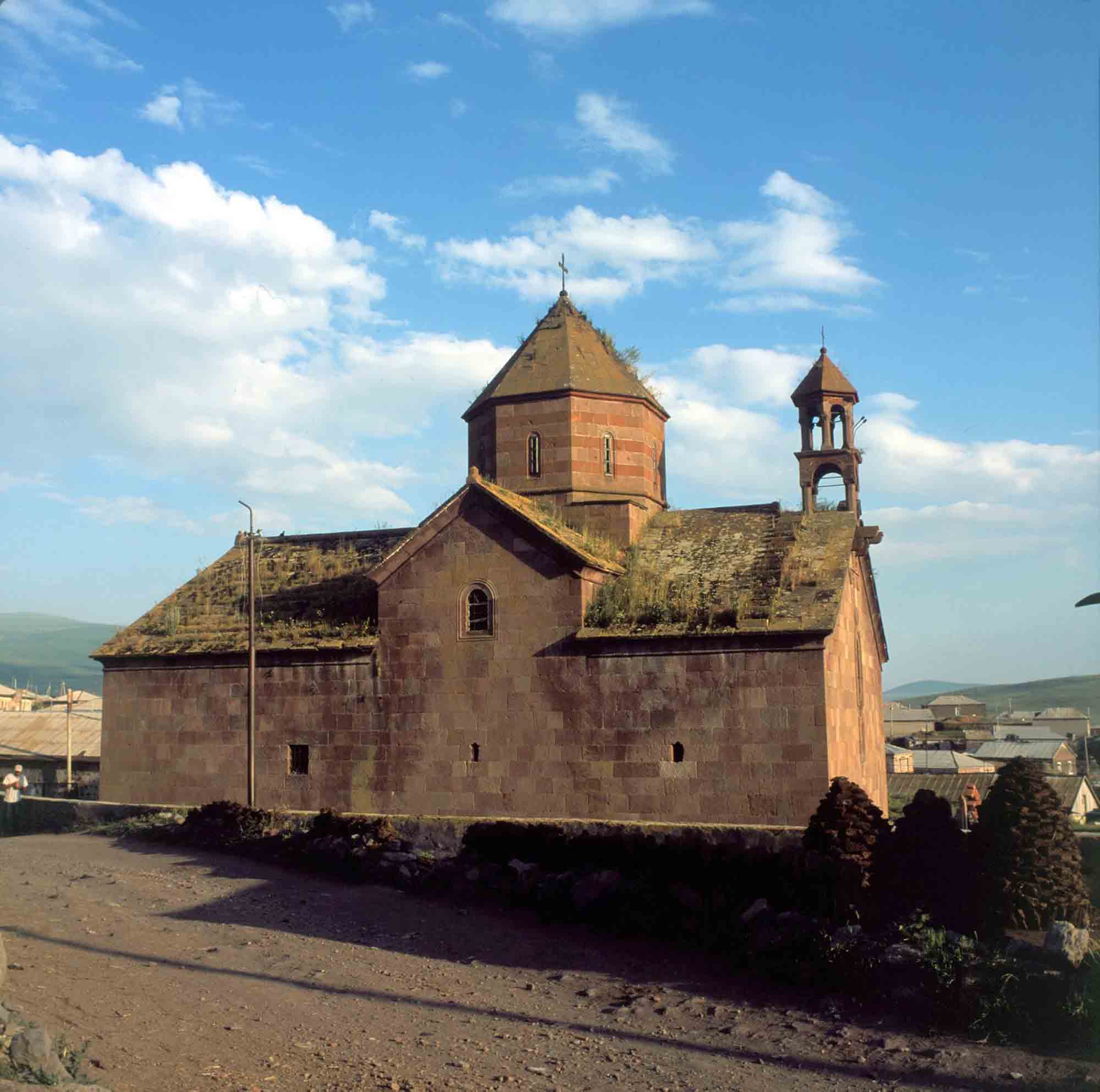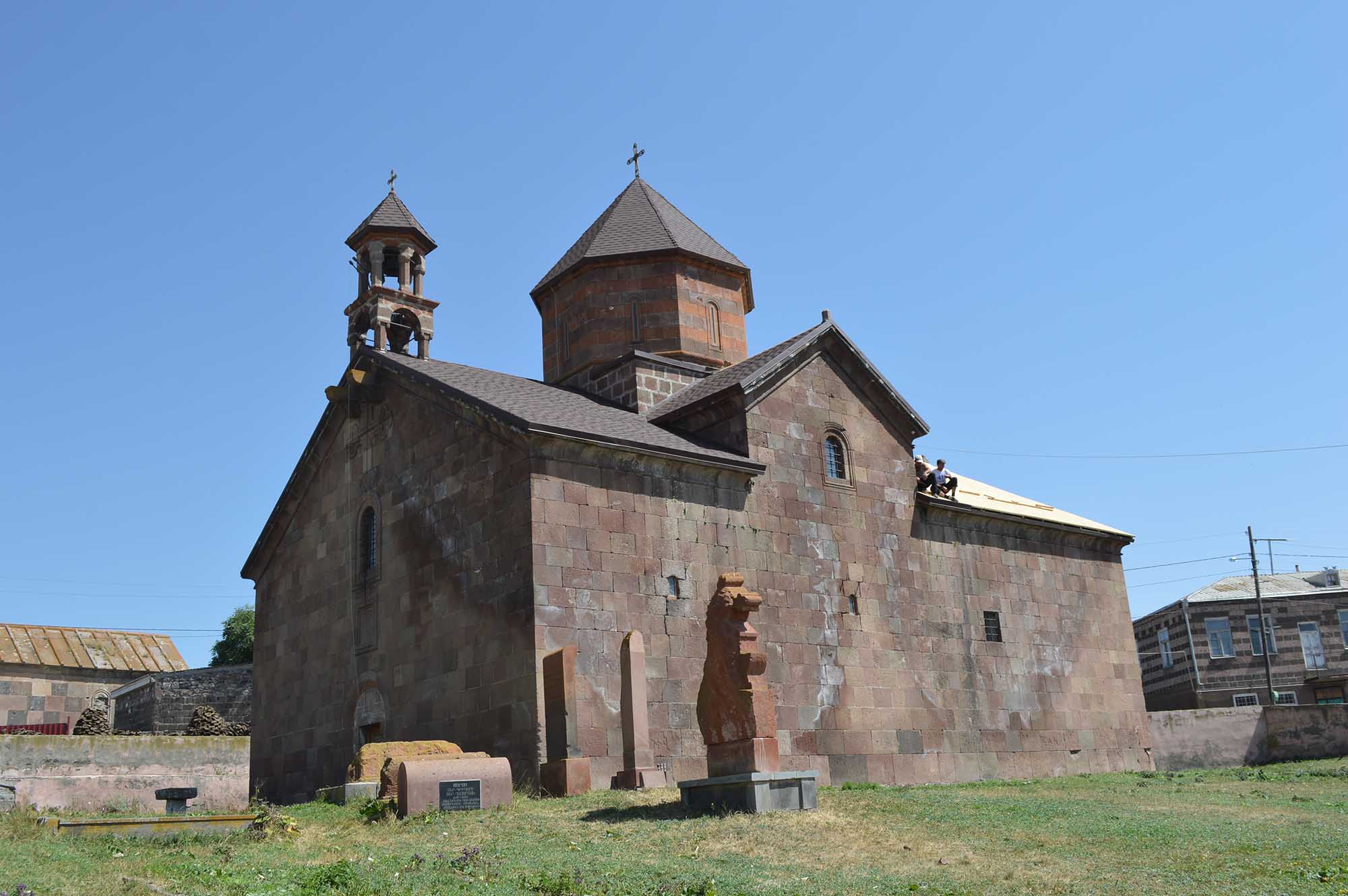Gandza – Surb Karapet (Saint Karapet) Church
 Establishment of the church: The current operating Surb Karapet (Saint Karapet) church with domes, built of stone, located in Gandza village, 22 km southeast from Akhalkalaki was established in 1859 [1]. It was founded with the means of the local public under the leadership of priest Grigor (Vahan Teryan's grandfather). The contemporary conveyed the following description related to the church, ''… It is a glorious church, with sacred hewn stone and vaulted on four columns; that church can bring pride to many cities; it is built with the tribute of people and with the support and care of the late priest Grigor'' [2]. About 15,000 rubles were spent on the construction of Surb Karapet church [3].
Establishment of the church: The current operating Surb Karapet (Saint Karapet) church with domes, built of stone, located in Gandza village, 22 km southeast from Akhalkalaki was established in 1859 [1]. It was founded with the means of the local public under the leadership of priest Grigor (Vahan Teryan's grandfather). The contemporary conveyed the following description related to the church, ''… It is a glorious church, with sacred hewn stone and vaulted on four columns; that church can bring pride to many cities; it is built with the tribute of people and with the support and care of the late priest Grigor'' [2]. About 15,000 rubles were spent on the construction of Surb Karapet church [3].
Surb Karapet church was always functioning and regularly underwent partial renovations. It serves the needs of the community today as well. The church is not reconsecrated and Divine Liturgies are being celebrated with Vemkar (the rock at the bottom of the Altar).
 Besides Surb Karaet church, there are two more vaulted churches in the village of Gandza named Upper and Inner (from 12th to 14th centuries). Those churches are built in accordance with the peculiarities of the Byzantine ritual. The Upper one (external dimensions are 10.54 x 6.86 m) has a small adjoining hall with a separate entrance from the northern side, one entrance from the southern side and Armenian inscriptions in Georgian. There is a territory of a village called ''Maghara'' with ruins of a church in the south-east of Gandza village [4].
Besides Surb Karaet church, there are two more vaulted churches in the village of Gandza named Upper and Inner (from 12th to 14th centuries). Those churches are built in accordance with the peculiarities of the Byzantine ritual. The Upper one (external dimensions are 10.54 x 6.86 m) has a small adjoining hall with a separate entrance from the northern side, one entrance from the southern side and Armenian inscriptions in Georgian. There is a territory of a village called ''Maghara'' with ruins of a church in the south-east of Gandza village [4].
There is also a medieval single-shipped church with the same name located on the top of Surb Hovhannes (Saint John) mountain, 3 km south-west of the village, at 2327 metres above sea level (external dimensions are 6,83 x 4,45 m). The latter is standing. It is built of solid stone, based on a two-level pedestal. The church is a place of pilgrimage for the faithful today. They come here on June 24 every year [5].
Architecture: In terms of architecture, Surb Karapet church is a domed structure built of stone. The external dimensions are 19,10 x 12,73 m. It is built of hewn stone. It stands on four columns [6].
Parish priests: In accordance with the church registers of Surb Karapet church in Gandza, among
School: The church parish school in the village of Gandza was opened in 1864 with the means and support of the local public. According to the diocesan schools' bulletin, as of 1869 the school had 40 students [11]. It is mentioned in the bulletin of 1875, that the village had a preschool located in the narthex of the church. Mkrtich Dyurkeryants is mentioned as a teacher [12].

Diocese of the Armenian Apostolic Church in Georgia
Armenian Historical and Cultural Heritage Research Center in Georgia
[1] S. Karapetyan, Javakhk, Yerevan, 2006, p. 137.
[2] ''Ardzaganq'', 1885, N 3, p. 41.
[3] ''Nar-Dos'', 1902, N 47, p. 3.
[4] S. Karapetyan, in the same place, p. 138-140.
[5] In the same place, p. 143.
[6] S. Karapetyan, in the same place.
[7] NAA, ֆ. 53, ց. 1, գ. 457, թ. 59-ի շրջ.
[8] NAA, ֆ. 53, ց. 2, գ. 1110, թ. 2.
[9] NAA, ֆ. 53, ց. 2, գ. 1117, թ. 2.
[10] NAA, ֆ. 53, ց. 2, գ. 1133, թ. 3.
[11] NAA, ֆ. 53, ց.1, գ. 3977, թ. 54-ի շրջ.
[12] NAA, ֆ. 56, ց. 15, գ. 52, թ. 43-ի շրջ.
 Հայերեն
Հայերեն  ქართული
ქართული  English
English  Русский
Русский 

